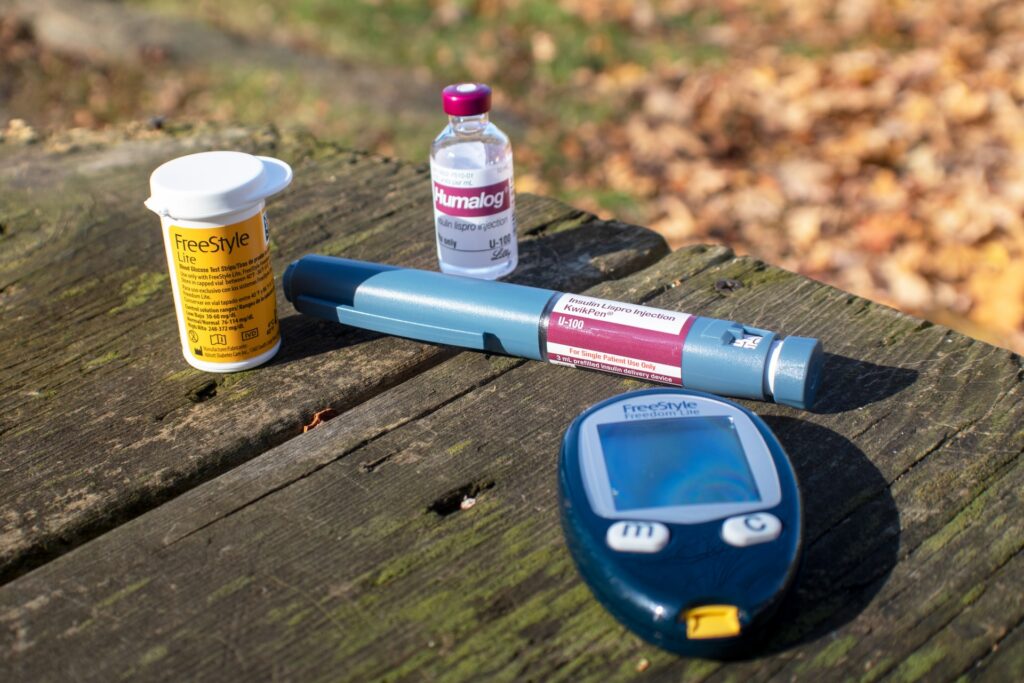Diabetes
It is to be noted that both type 1 and type 2 diabetics are recommended to follow general healthy nutritional guidelines, however as type 1 diabetics are required to take insulin shots in some cases they might need to quickly raise their blood sugar levels after injecting too much insulin or not eating enough carbohydrates after the insulin short in order prevent hypoglycemia, which is a dangerous medical condition, where blood glucose levels drop too low and it may cause fainting coma and even death. In case of occurrence of such situations, type 1 diabetics would be recommended to carry a snack, that is high in sugar and can be quickly ingested. Such a snack could be a sugary drink or chocolate bar. Such situations can also be prevented by consulting the doctor on how much carbohydrates to eat after the insulin shot, learning how to read the nutritional tables of consumed products and sticking to the doctor’s guidelines.
Nutritional therapy
The application of food therapy to help manage diabetes relies on recommending foods that have certain properties, which could help to manage diabetes and its symptoms, such as poor blood circulation, increased hunger or abnormal blood glucose levels. Such foods would usually contain certain nutrients that would show benefits for diabetic patients. Examples of foods that can be implemented to support diabetics are:
- Foods high in arginine (e.g. walnuts, turkey breast, legumes or seaweed) could help manage some symptoms of diabetes as amino acid arginine is known to cause vasodilation and increase blood flow and could potentially be helpful to those suffering from CVDs caused by diabetes(1), can improve utilisation of glucose and stimulates GLP-1, which is an intestinal hormone that regulates appetite(2)
- Healthy sources of carbohydrates that also contain other micronutrients, such as fruits, vegetables, whole grains, legumes(3)
- Low fat, unsweetened, fermented dairy products such as kefir, buttermilk or yoghurt that positively impact the health of gut microbiota or other fermented products e.g. sauerkraut as dysbiosis of the intestinal microbiome is linked to diabetes(4)
- Foods rich in fibre, which moderates how the body digests and absorbs nutrients from food (3)
- Oily fish that contain high amounts of omega-3 fatty acids, which can improve insulin sensitivity and protect from CVDs along with garlic that can also protect from heart diseases(5,6,7)
Diabetes guidelines
According to Mayo Clinic(3) following guidelines can be used:
- Fill half of your plate with non-starchy vegetables
- Fill a quarter of the plate with a lean protein source
- Fill the remaining quarter of the plate with starchy vegetables or whole grains (e.g. brown rice)
- Include healthy fats (raw nuts and seeds, avocado, olive oil) in small amounts as they are high in calories
- Include a portion of fruit or dairy and a glass of water or other unsweetened drink such as tea for example
Diabetes meal plan
An example one day meal plan could include:
- Breakfast: Rolled oats with kefir, berries and a banana
- Dinner: Buckwheat, oven-baked turkey breast, half an avocado, spinach, kale and sauerkraut
- Supper: A slice of salmon, a handful of nuts, green tea with ginger and a salad with tomatoes, garlic and onions
- Snacks throughout the day: an orange and a dragon fruit
The patient would also be instructed to avoid saturated fats, fast foods, sweets, sugary drinks and foods high in salt, except for type 1 diabetics, which under certain circumstances are required to quickly raise their blood sugars to prevent the occurrence of hypoglycemia. Type 1 diabetics would be also recommended to regularly measure and monitor their blood sugar levels.
References:
- WebMD(2019), Arginine: Heart Benefits and Side Effects, accessed on 21/05/21, available at: https://www.webmd.com/heart/arginine-heart-benefits-and-side-effects
- David Heitz(2018), Arginine Could Treat Early Symptoms of Type 2 Diabetes, accessed on 12/05/21, available at: https://www.healthline.com/health-news/diabetes-arginine-in-diet-could-help-treat-type-2-diabetes-091213
- Mayo Clinic, Diabetes diet: Create your healthy-eating plan, accessed on 12/05/21, available at: https://www.mayoclinic.org/diseases-conditions/diabetes/in-depth/diabetes-diet/art-20044295
- Wanping Aw & Shinji Dukuda(2018), Understanding the role of the gut ecosystem in diabetes mellitus, Journal of Diabetes Investigation , available at: https://www.ncbi.nlm.nih.gov/pmc/articles/PMC5754518/
- Benjamin Albert et. al.(2014), Higher omega-3 index is associated with increased insulin sensitivity and more favourable metabolic profile in middle-aged overweight men, available at: https://www.nature.com/articles/srep06697
- A. P. Jain et. al.(2015), Omega-3 fatty acids and cardiovascular disease, European Review for Medical and Pharmacological Sciences, available at: https://www.europeanreview.org/article/8446
- Daniela Ginta(2020, Can You Eat Garlic If You Have Diabetes?, accessed on 12/05/21, available at: https://www.healthline.com/health/diabetes/garlic-and-diabetes




